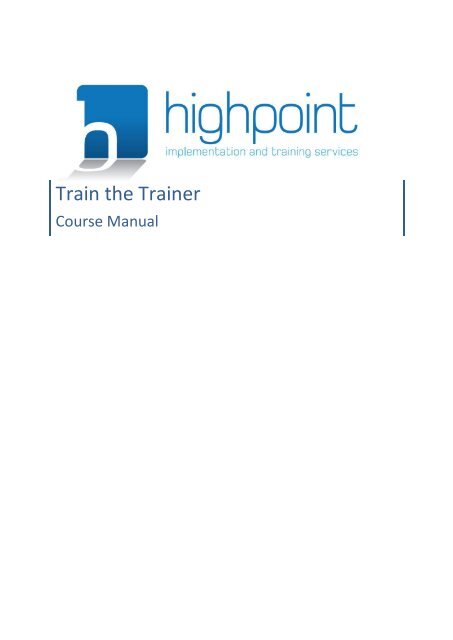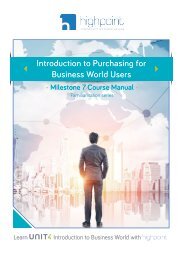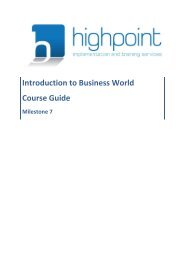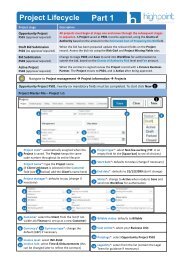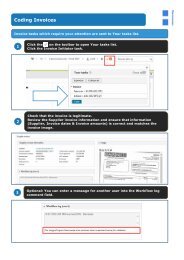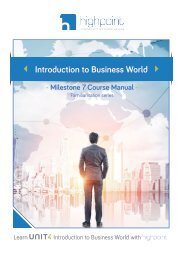HP TrainTheTrainer Course Manual
Create successful ePaper yourself
Turn your PDF publications into a flip-book with our unique Google optimized e-Paper software.
Train the Trainer<br />
<strong>Course</strong> <strong>Manual</strong>
Notices<br />
Highpoint Implementation and Training Services Ltd has made every effort to supply<br />
accurate, complete and up to date information in this document. However, if changes are<br />
made to the system, the information in this document may no longer be accurate at the<br />
time of use. Highpoint Implementation and Training Services Ltd assumes no responsibility<br />
for any errors or omissions that may occur in the document.<br />
Microsoft® Excel, Windows® and Microsoft® SQL Server are either registered trademarks<br />
or trademarks of Microsoft Corporation in the United States and/or other countries. All<br />
other brand names, product names and company logos are trademarks or registered<br />
trademarks of their respective owners.<br />
This document contains information that is proprietary to Highpoint Implementation and<br />
Training Services Ltd. Please do not reproduce this document or make it available to any<br />
third party either directly or indirectly in any format. If you do require more copies for any<br />
purpose, please contact Highpoint Implementation and Training Services for authorisation.<br />
All rights reserved.<br />
Highpoint Implementation and Training Services © 2019
Contents<br />
Notices .............................................................................................................................. 2<br />
Section 1: How Adults Learn .................................................................................................. 4<br />
Section 2: Change Curve ........................................................................................................ 5<br />
Section 3: Accelerated Learning ............................................................................................. 8<br />
Eight Ideas for Enhanced Learning ..................................................................................... 8<br />
Accelerated Learning ......................................................................................................... 8<br />
SAVI ................................................................................................................................... 8<br />
The Learning Zone ............................................................................................................. 9<br />
The Learning Cycle ........................................................................................................... 11<br />
Teaching by Webinar and Conference Call ....................................................................... 12<br />
Promote Discovery .......................................................................................................... 13<br />
Facilitation - Key Skills ...................................................................................................... 13<br />
Facilitation - Controlling the Room ................................................................................... 14<br />
Facilitation - Being the Weather-maker ........................................................................... 14<br />
Three Ways of Learning ................................................................................................... 15<br />
Section 4: Jargon Busting ..................................................................................................... 16<br />
Section 5: Key Training Tips ................................................................................................. 17<br />
Key Indicators .................................................................................................................. 17<br />
Key Solutions ................................................................................................................... 17<br />
Key Challenges ................................................................................................................. 17<br />
Section 6: The Importance of Feedback ............................................................................... 19<br />
Ways of Gathering Feedback ........................................................................................... 19<br />
Summary ......................................................................................................................... 20
Train the Trainer <strong>Course</strong> <strong>Manual</strong><br />
Section 1: How Adults Learn<br />
Malcolm Shepherd Knowles (1913 – 1997) was an American educator well known for the use<br />
of the term Andragogy as synonymous to adult education. According to Malcolm<br />
Knowles, andragogy is the art and science of adult learning, thus andragogy refers to any<br />
form of adult learning. (Kearsley, 2010).<br />
The term andragogy can be supposedly equivalent to the term pedagogy. Andragogy in<br />
Greek means man-leading in comparison to pedagogy, which in Greek means child-leading.<br />
In 1980, Knowles made 4 assumptions about the characteristics of adult<br />
learners (andragogy) that are different from the assumptions about child learners<br />
(pedagogy). In 1984, Knowles completed his 6 assumption in 1984:<br />
Motivation – As a person matures the motivation to learn is internal.<br />
Context required - As a person matures our learning shifts from subject to problem solving,<br />
we no longer feel the need to study and understand an entire subject but only the parts that<br />
we need to solve the problem.<br />
Life experience - As a person matures he/she accumulates a growing reservoir of experience<br />
that becomes an increasing resource for learning.<br />
Self-Concept - As a person matures his/her self-concept moves from one of being a<br />
dependent personality toward one of being a self-directed human being.<br />
Need to know - Life is busy. Adults are busy. Adults are actively engaged in the process of<br />
life. We want to know what we need to know as rapidly as possible ensuring it is worth our<br />
effort to learn it.<br />
Readiness to learn - As a person matures his/her readiness to learn becomes oriented<br />
increasingly to the developmental tasks of his/her social roles.<br />
Knowles’ 4 Principles of<br />
Andragogy<br />
In 1984, Knowles suggested 4 principles that are applied to adult learning:<br />
Page 4 of 20<br />
©Highpoint 2019 highpoint-services.co.uk
Train the Trainer <strong>Course</strong> <strong>Manual</strong><br />
1. Adults need to be involved in the planning and evaluation of their instruction.<br />
2. Experience (including mistakes) provides the basis for the learning activities.<br />
3. Adults are most interested in learning subjects that have immediate relevance and<br />
impact to their job or personal life.<br />
4. Adult learning is problem-centred rather than content-oriented. (Kearsley, 2010)<br />
Application of Andragogy in Personal Computer Training<br />
Knowles (1984) provides an example of applying andragogy principles to the design of<br />
personal computer training:<br />
1. There is a need to explain the reasons specific things are being taught (e.g., certain<br />
commands, functions, operations, etc.)<br />
2. Instruction should be task-oriented instead of promoting memorization -- learning<br />
activities should be in the context of common tasks to be performed by the others.<br />
3. Instruction should consider the wide range of different backgrounds of learners; learning<br />
materials and activities should allow for different levels/types of previous experience<br />
with computers.<br />
4. Since adults are self-directed, instruction should allow learners to discover things and<br />
knowledge for themselves without depending on people. However, learners should be<br />
offered guidance and help when mistakes are made.<br />
How can you use this understanding to ensure you create an impactful learning<br />
environment?<br />
Section 2: Change Curve<br />
Stage 1 begins when a change is first introduced, where people's initial reaction may be<br />
shock or denial. This manifests by blaming others as they react to the challenge of the status<br />
quo.<br />
Stage 2 they become critical of themselves. For as long as people resist the change and<br />
remain at Stages 1 and 2 of the Change Curve, the change will be unsuccessful, at least for<br />
the people who react in this way. This is a stressful and unpleasant stage. It should also be<br />
noted that people can waver between these two stages for quite some time.<br />
Stage 3 is where confusion and doubt set it, but it’s a good sign as people are beginning to<br />
move on. This manifests in various ways but people will show signs of doubt and confusion.<br />
Signs of acceptance will, however shine through, as they may ask questions such as:<br />
Page 5 of 20<br />
©Highpoint 2019 highpoint-services.co.uk
Train the Trainer <strong>Course</strong> <strong>Manual</strong><br />
• Will I ever be able to learn all this?<br />
• How will this affect my job?<br />
• How do I use this new system?<br />
Stage 4 of the Change Curve - Acceptance Rationalisation - people stop focusing on what<br />
they have lost. They start to let go and accept the changes. They begin testing and exploring<br />
what the changes mean, and so learn the reality of what's good and not so good, and how<br />
they must adapt. It is useful to be cautious at this stage of people sliding backwards into<br />
doubt, can be common.<br />
Stage 5, Solutions and Problem Solving, people not only accept the changes but also start to<br />
embrace them. They begin to rebuild their ways of working.<br />
Stage 6. The change is now starting to become ‘normal’ or the beginnings of routine and<br />
status quo. Learnings can now be captured through a review process and feed into the next<br />
cycle of change.<br />
Page 6 of 20<br />
©Highpoint 2019 highpoint-services.co.uk
Train the Trainer <strong>Course</strong> <strong>Manual</strong><br />
Page 7 of 20<br />
©Highpoint 2019 highpoint-services.co.uk
Train the Trainer <strong>Course</strong> <strong>Manual</strong><br />
Section 3: Accelerated Learning<br />
Eight Ideas for Enhanced Learning<br />
Accelerated Learning<br />
Accelerated Learning (A.L.) is in many ways simply an engaging way of facilitating learning.<br />
It guides you in making the best choices in how to set-up the learning environment, in the<br />
design of training sessions to meet the needs of all learners, and in facilitating so that the<br />
learning process is both deepened and accelerated, allowing delegates to retain more and<br />
feel further empowered. They apply learning more effectively at work and in their personal<br />
lives. Their ability to think critically systemically and innovatively increases. They become<br />
more adapt and agile learners.<br />
The ideas are derived from the study of years of interdisciplinary research and constant<br />
charges as we learn more about learning and human development. The methodology<br />
integrates new and helpful ideas and approaches which are laid out below.<br />
SAVI<br />
We learn through a blend of different learning techniques when we deliver a course we must<br />
ensure we utilise all aspects to fully enhance the delegates learning;<br />
S stands for Somatic learning or learning by moving and doing. Somatic learning involves<br />
getting active from time to time, for example, while building a model of a process or<br />
procedure, doing active learning exercises (simulations, system challenges), or creating<br />
pictograms or maps.<br />
A is Auditory, which is learning by talking and hearing. Auditory learning is getting the<br />
learners to translate their experience into sound by talking about what they are learning.<br />
Auditory learning encourages learners to read out loud, talk while solving problems, and<br />
review learning experiences.<br />
V is for Visual and is learning by observing and picturing. Visual learning work best when<br />
they can see real-world examples, icons, pictures, and various kinds of images while they are<br />
learning. Sometimes encouraging learners to utilise maps and diagrams to learn key<br />
information like work flow or attributes and relations.<br />
I stands for Intellectual, it’s important to encourage learners to write notes in their own<br />
words. This will help retention of knowledge as well has helping them to check their own<br />
understanding of the topic.<br />
Page 8 of 20<br />
©Highpoint 2019 highpoint-services.co.uk
Train the Trainer <strong>Course</strong> <strong>Manual</strong><br />
Can<br />
you<br />
include all of these forms of learning into your classroom? Some ideas for Webinars:<br />
Somatic<br />
Can you simulate a journey through the software? A narrative or story can give this<br />
impression even sitting at a desk.<br />
Auditory<br />
Can delegates express an idea in one short sentence? Can webinar users compare<br />
sentences? Which are the most effective?<br />
Visual<br />
Do your graphics tell the story? Can you show a process in different pictorial ways?<br />
Intellectual<br />
Have you encouraged your delegates to write hand-written notes, or annotate printed<br />
ones? Numerous studies show that hand writing improves retention over typing.<br />
The Learning Zone<br />
If our learners are in discomfort either through being hungry or tired or even feeling<br />
overwhelmed or overly challenged it will become a distraction from learning. As trainer we<br />
need to create a positive environment for learning. One way we can achieve this is by<br />
Page 9 of 20<br />
©Highpoint 2019 highpoint-services.co.uk
Train the Trainer <strong>Course</strong> <strong>Manual</strong><br />
ensuring that our delegates needs are meet a simple model to highlight this is Maslow’s<br />
Hierarchy of Needs.<br />
5<br />
Now they are ready to learn<br />
4<br />
Have you effectively praised and encouraged the delegates?<br />
3<br />
Do they feel part of a group have you spent time bring the<br />
room together?<br />
2<br />
Do they feel safe in their environment, is the room a<br />
comfortable place to be?<br />
1<br />
Are your delegates tired, hungry, thirsty etc?<br />
5<br />
4<br />
3<br />
1<br />
2<br />
Page 10 of 20<br />
©Highpoint 2019 highpoint-services.co.uk
Train the Trainer <strong>Course</strong> <strong>Manual</strong><br />
The Learning Cycle<br />
When we train in new materials we need to take them on a journey from first being<br />
introduced to the materiel to being able to use and excel in the newly acquired skill, we call<br />
this process the learning cycle;<br />
Preparation – We need to inspire the delegates and encourage them to want to learn. When<br />
presented with new information the first thoughts we have is ‘what’s in it for me’ (WIIFM<br />
factor) Before presenting any new information we need to first explain why they should<br />
learn it and how it will benefit their lives.<br />
Presentation – After the delegates are ready to learn we then need to present the new<br />
information to them. This step is key in setting the foundation of how they will potentially<br />
view this topic from then on. If we present this information with positivity then the learners<br />
will view it in a positive light, controversy if we are introduced to something negatively then<br />
this will affect their view of the topic<br />
Practise – Regardless of natural learning style, everyone learns by ‘doing’. Empower your<br />
learner by getting them to undertake actions with the mouse and keyboard.<br />
Performance – ‘Message sent’ does not necessarily mean ‘Message received’. Ask you<br />
learner to repeat back to you or demonstrate their understanding<br />
Preparation<br />
Presentation<br />
Performance<br />
Practise<br />
Page 11 of 20<br />
©Highpoint 2019 highpoint-services.co.uk
Train the Trainer <strong>Course</strong> <strong>Manual</strong><br />
Teaching by Webinar and Conference Call<br />
There has been very little study into the effectiveness of webinar teaching. Most of the<br />
evidence for what works and doesn’t work has been anecdotal, as in these examples:<br />
Tips and Techniques for Making Good Webinars: Engaging Your Audience<br />
1. Get them interacting. The more your participants participate in a webinar, the more<br />
engaged they'll be. ...<br />
2. Have interesting slides. ...<br />
3. Increase the number of slides. ...<br />
4. Break up the class into digestible sections. ...<br />
5. Call for questions often.<br />
or<br />
1. Keep it brief. Since you do not have the visual cues from your audience that you do in a<br />
traditional classroom, you have no way of knowing whether they are sitting in rapt attention or<br />
yawning and checking Facebook. Aim for your webinar to last 20 minutes, or the length of the<br />
average adult’s attention span. If you are also incorporating a Q&A portion, you can certainly up<br />
that timeframe by an additional 10 to 15 minutes. If you cannot fit all of your material into 20<br />
ticks on the clock, break it up into a series of webinars instead.<br />
2. Think visual. Remember the importance of visual aids. Once again, it comes down to your<br />
audience’s fickle attention span. Giving them more to look at will ensure you are holding their<br />
attention, so now is the time to take advantage of the many tools available to you. Add in photos<br />
to further describe your topic, experiment with split-screen video demos and select a lively host.<br />
This can be the difference between a ho-hum presentation and one that people will remember<br />
and really learn from.<br />
3. Get ready for your close-up. Whether you are hosting a webinar yourself or you have hired a<br />
host, you will want to follow some simple on-camera rules. If possible, opt for natural lighting,<br />
stand or sit in front of a solid background, and wear a solid colour that contrasts with your<br />
background (if your background is dark, for example, opt for a light-coloured shirt, and vice<br />
versa). Using a webcam? Place it right above your monitor so it looks like you are looking right at<br />
your audience even when you are sneaking a peek at your presentation.<br />
4. Engage your audience. The buzzword with media these days is “interactive.” Play the same<br />
game with your webinar. By keeping it less like a seminar and more like an interactive learning<br />
experience, you will keep your audience’s attention. Live polls, quizzes, chat and Q&A sessions<br />
help participants find each other and spark discussions that will go a long way toward webinar<br />
success.<br />
5. But don’t stop there. Remember that the experience isn’t over after “class is dismissed.” Keep<br />
your momentum going by following up and thanking your participants (provide links to the<br />
highlights and surveys to keep them engaged after the fact). Also, for those who weren’t able to<br />
make it, have your webinar archived so they can find you after the fact.<br />
The main point with webinars is that they are unusually tiring for trainers and delegates, and<br />
that if they can be broken into bite-sized chunks it would be most appropriate. 60 – 90 minutes<br />
seems to be about the longest that can be undertaken without some sort of break.<br />
Page 12 of 20<br />
©Highpoint 2019 highpoint-services.co.uk
Train the Trainer <strong>Course</strong> <strong>Manual</strong><br />
Promote Discovery<br />
We can’t spoon feed our delegates, and if we want the learning to stick, if we want them to<br />
leave the training room feeling prepared. What we need to do is motivate and develop<br />
excitement, so they want to learn and inspired to take their new learning and develop it. In<br />
2009 Dan Pink realised a book called ‘Drive’ focusing on motivation. This was born out of a<br />
study carried out by three leading economists from MIT. The book focuses on how we are all<br />
intrinsically motivated. The results drawn from this can be utilised to understand how we<br />
can motivate a desire to for self-discovery within our delegates.<br />
Autonomy - People want the desire to be in control of their own learning. It’s not about<br />
compliance, this will only give take you so far and what we should be seeking to do is use the<br />
training session as an opportunity to give people the basics. The tools and the motivation so<br />
they can leave encouraged and inspired to go ahead and take autonomy over their own<br />
development, knowing where they can go for help and ideas beyond the classroom.<br />
Mastery – We all have a desire to get better, why do people learn a complex musical<br />
instrument or write Wikipedia pages? People are driven to challenge and then mastery. So,<br />
in the training room let’s harness that desire and challenge our learners to develop their<br />
knowledge and give them support to master it.<br />
Purpose – Many delegates become disengaged and demotivated because they don't<br />
understand, or can't invest in, the "bigger picture." However, those who believe that they<br />
are working toward something larger and more important than themselves are often the<br />
most hard-working, productive and engaged. It vital that we help our learners see their<br />
purpose for learning something new.<br />
Facilitation - Key Skills<br />
Often within the training room the answers are present within your delegates, as trainers it<br />
is our responsibility to utilise our delegates individual knowledge and experiences. This will<br />
empower our leaners as they come to realise that they can reconcile this new skill and in<br />
turn master. We do this through continually asking the delegates to present their<br />
knowledge, asking questions and by setting up and guiding discussions/challenges.<br />
Prepare - Being prepared is probably one of the most important yet often overlooked aspect<br />
of facilitation. Preparation includes understanding the profile of people you are meeting,<br />
assessing the dynamics of the room, determining the focus areas and, setting the desired<br />
outcome that you want to achieve at the end of the session. Being prepared also provides<br />
you with more credibility and helps everyone make the best out of the limited time to<br />
accomplish the key learning objectives. (Can you see how this relates to Maslow’s<br />
Hierarchy?)<br />
Frame the setting - It is common for people to enter a training session with different<br />
agendas. This means, without a common thread to frame their mind, discussions will simply<br />
deviate everywhere and that can easily lead to a discussion with no conclusion. What you<br />
can do is to set the stage right from the start and ensure that everyone is on the same page.<br />
Lay the ground rules, manage the expectations and get everyone to agree that this is how<br />
we are going to approach the subject. With that, it is easy for you to bring back the team<br />
from distractions if someone deviates from the topic along the way. That said, the prerequisite<br />
to this is preparation and a good understanding of what the end goal is.<br />
Take control - As a facilitator, you are the most powerful figure in the room. You hold the<br />
authority to move discussions and get people involved. Do not be afraid to speak up and<br />
intervene is someone is trying to dominate the conversation. Ask yourself, is the purpose to<br />
solve a pre-set challenge or observe a monologue? To fulfil the objective of promoting<br />
Page 13 of 20<br />
©Highpoint 2019 highpoint-services.co.uk
Train the Trainer <strong>Course</strong> <strong>Manual</strong><br />
purposeful discussions to get a resolution where everyone is aligned, a good facilitator needs<br />
to take control and get everyone involved as much as possible. Participants will only be fully<br />
committed on the journey to learn if their voices are heard.<br />
Uncover insights, not provide them - As a facilitator, your role is not to provide the meeting<br />
with answers. What you should focus on is to bring out the answers out of the participants,<br />
draw deeper insights by asking questions and in turn, help piece things together to present a<br />
clearer picture for everyone. To do so, avoid making assumptions. When in doubt, clarify.<br />
Spend time to get participants thinking and sharing their views because that’s what is key to<br />
uncovering meaningful insights. After going through many sessions, you will realize that the<br />
answers are often already present. It’s just a matter of piecing the bite-sized information<br />
together and helping them dig deeper to understand what it really means.<br />
Close with impact - A proper closing will help keep everyone on the same page once again<br />
and committed to the common goal. It is important for the facilitator to round things up by<br />
recapping the salient points and get consensus on the next steps moving forward. With that,<br />
expectations will be clear, and everyone will be on the journey to achieve the goals set out<br />
together. This may not mean that everyone in the room knows everything, but that they<br />
know where to go to get the information.<br />
Facilitation - Controlling the Room<br />
Within a training room you can find multiple different personalities, some will be bold and<br />
willing to vocalise their point as well as dominate any group challenges or the training room.<br />
Others will be softer spoken and unable or too nervous to speak up. How can we can ensure<br />
that we utilise those who are vocal to aid in encouraging the room to be forth coming with<br />
their answers, but still allow the quieter members of the room the opportunity to speak?<br />
A simple method is to thank the more vocal members for their contribution and then ask if<br />
anybody has a thought on the subject at hand. However, it is very important that we<br />
establish a set of ground rules at the start of the training session. Encouraging the delegates<br />
to listen to each other and enforcing the belief that there are no silly question or answers,<br />
thus encouraging everybody to speak up without fear of reprisal. Getting to know the<br />
delegates and their names is extremely useful here in picking out those who may not<br />
volunteer answers but can be used to steer the conversation.<br />
If you need to be critical, try to do it in a warm and generous way.<br />
Can you think of any other methods we can utilise in this situation?<br />
Facilitation - Being the Weather-maker<br />
A fun, safe and engaging training room where answers and options are encouraged, and the<br />
learning is engaging, will promote positive long-lasting learning. However, if it dull and<br />
lifeless the delegates will quickly become disengaged with the learning process. A simple<br />
way to ensure a positive learning environment is to think about the weather you create in<br />
the training room, through your demeanour.<br />
Our delegates are looking to us to lead them through the day and will quickly emulate our<br />
projected emotions, if we are being the bright sunshine then this will lift the mood and help<br />
make both the room and the delegates feel bright and sunny. Obviously, this needs to be a<br />
believable and credible.<br />
Page 14 of 20<br />
©Highpoint 2019 highpoint-services.co.uk
Train the Trainer <strong>Course</strong> <strong>Manual</strong><br />
Layering<br />
People seldom learn from doing something just once, but from the utilisation of repeated<br />
examples, that add levels of complexity as they grow.<br />
Use the simplest scenarios first until the learner fully grasps the concept, creates a solid<br />
understanding and ground work; only then can you slowly build on more complex elements<br />
of the process you are following. Remember a training room is a simple a grounding point,<br />
allowing our learners to develop key principles and knowledge that will empowered them to<br />
self-discovery beyond the training room.<br />
Think about learning to drive – it is a complex layered process that we all take for granted.<br />
Three Ways of Learning<br />
Not all learning in real life happens through ‘just reading it through’. Instead we often just<br />
plunge in and learn in the process. Our own responses to situations also provide us with<br />
learning opportunities if we stop to think about them.<br />
We can replicate this in the training room by presenting information, creating experiences<br />
and helping people learn from their own reactions.<br />
Page 15 of 20<br />
©Highpoint 2019 highpoint-services.co.uk
Train the Trainer <strong>Course</strong> <strong>Manual</strong><br />
Section 4: Jargon Busting<br />
Try not to use terms and abbreviations that maybe outside the knowledge of the learner.<br />
Remember Business World has its own vocabulary that the learner will be unfamiliar with.<br />
When explaining a new term there are two methods first one is to explain it ensuring we are<br />
mirroring real life.<br />
Alternatively encourage the delegates to discover the answer for themselves, by setting it as<br />
a challenge and inviting them to utilise their manuals and help icon on screen. This will<br />
encourage them to do so when they return to work.<br />
Above all remember to always explain the meaning of Business world terms and acronyms.<br />
These are particularly difficult when using a standard word in a non-standard context (e.g.<br />
“relations” in Business World are directional transactions).<br />
Examples:<br />
Browser Drill-down Funds checking Resno.<br />
Workflow Three-way match GRN Wildcard<br />
Attributes Alerts BACS Relation<br />
Page 16 of 20<br />
©Highpoint 2019 highpoint-services.co.uk
Train the Trainer <strong>Course</strong> <strong>Manual</strong><br />
Section 5: Key Training Tips<br />
Key Indicators<br />
Reading the room - Before you start your training session take time to watch the room,<br />
work out who are talkative, who are dominant and who are quiet - this information can be<br />
extremely useful when you are training.<br />
Body Posture - A person’s posture tells you a lot about their status, if somebody is sat with<br />
the arms folded, or they are leaning back in the chairs this can be a clear indication of<br />
disengagement.<br />
Non-Responsive – If you are asking questions attempting to generate conversations but are<br />
receiving little to no response in return then it may be time to mix things up an re-energize<br />
the room.<br />
Key Solutions<br />
Change the stance - this can either by getting the delegates active and moving (for example<br />
asking them to move one space to the left or right) or yourself by changing tone, inflection<br />
of voice, even as simple as sitting down or standing up can recharge the room.<br />
Power of the 5-minute Break - Learners are only at the maximum peak of attention for a<br />
relatively short period of time. Watch for signs of their attention wandering and take a short<br />
break. This also presents you with an opportunity to tailor your attention to members of the<br />
room who are a bit behind or provide extra materials for people who are ahead of the game.<br />
Don’t ignore it - If somebody is talking through the session, challenging your authority or the<br />
room is switching off don’t ignore it. Deal with it swiftly before the problems develops and<br />
becomes unmanageable, below are just a few solutions on how to respond to a few<br />
common problems;<br />
Talking while you are/challenging your authority – A simple challenge is just to stop<br />
talking yourself and observe the individual talking they will quickly become aware<br />
and cease. Never call them out over it or try and talk over them this will create<br />
barriers between you and the delegates. If this problem stems from a delegate utilise<br />
a break to quickly speak with them, remember our theory of Andragogy and gage<br />
their enthusiasm for the course or the learning.<br />
Switching off – A simple method is just to change the stance (see above)<br />
Key Challenges<br />
Tortoise and the hare - Adults learn best by doing and by given the opportunity to try for<br />
themselves. However, some delegates will complete a challenge set to them in very quick<br />
order (Hares) where as others may need slightly longer to achieve their goal (tortoise) the<br />
challenge as trainer is how you keep the hares interested, while supporting the tortoise and<br />
ensuring they are given the opportunity they need. A simple solution is to always have a<br />
secondary challenge ready to set, when your hares complete their challenge set them<br />
another. This cannot be around additional learning as the tortoise may feel they are slipping<br />
behind and become disengaged.<br />
Difficult Questions – If you are asked a question you don’t know the answer to do not try<br />
and bluff your way through. Make a note and tell the learner you will get back to them.<br />
Make sure you do! One simple method is a question car park:<br />
Page 17 of 20<br />
©Highpoint 2019 highpoint-services.co.uk
Train the Trainer <strong>Course</strong> <strong>Manual</strong><br />
Disengagement – If the<br />
delegates are complete<br />
closed to any learning or<br />
the course in general, don’t<br />
been drawn into the<br />
argument about the merits<br />
of the course or try to<br />
carry on and ignore the<br />
problem. Instead<br />
generate a discussion<br />
about why they need to<br />
learn this and how it will<br />
benefit them. Designment typically transpires due to a lack of understanding of why the<br />
need to learn it.<br />
Page 18 of 20<br />
©Highpoint 2019 highpoint-services.co.uk
Train the Trainer <strong>Course</strong> <strong>Manual</strong><br />
Section 6: The Importance of Feedback<br />
Ensure you are always obtaining feedback from your learners following the training session.<br />
Also take time to reflect on how you can further improve your coaching style and content.<br />
Keep notes for next time to allow you to develop further and ensure learning as taken place<br />
in three key areas:<br />
Retention - Has learning taken place?<br />
Continued engagement – It allows you to offer further support to your delegates. Alongside<br />
highlight those who struggled that day and speak to their line manager to arrange further<br />
support.<br />
Improve – Feedback can help you improve course delivery as well as your own personal<br />
development.<br />
Ways of Gathering Feedback<br />
1. A simple form given to your delegates at the end of the session<br />
2. Email response/ online feedback form<br />
3. Using a quiz at the end (this can work particularly effective if you use the same quiz<br />
at the start of your training session)<br />
4. You can gather the vast majority of the data with one simple question – What could I<br />
have done today to make the day work better?<br />
5. Remember that delegates may be positive on the day but write negative feedback.<br />
This can be mitigated by ensuring that they know you have taken on board the<br />
answers to this question. Allowing everyone to leave early may be superficially<br />
popular but result in negative feedback.<br />
Can you think of any other methods of feedback?<br />
Remember your coaching session doesn’t end when you walk away. Make a point of<br />
following up with the learning to see how they are getting on and if there is anything they<br />
need further help with. Make sure they can get in touch with you, and potentially with each<br />
other for peer support.<br />
Page 19 of 20<br />
©Highpoint 2019 highpoint-services.co.uk
Train the Trainer <strong>Course</strong> <strong>Manual</strong><br />
Summary<br />
The best kind of training is supportive. Delegates need to feel safe to reveal their own<br />
ignorance and make mistakes in order to progress, even if this would not be acceptable<br />
outside of a training session.<br />
The effective training room acts as a safe zone where people can make mistakes, bond over<br />
their joint ignorance and help each other to learn. In a competitive corporate culture this<br />
may mean that the training session benefits from being clearly marked out as a separate<br />
space to their regular workspace. It’s a space with training wheels and a helmet. This will<br />
encourage everyone to pedal as hard and as fast as they can without worrying about falling<br />
off.<br />
Page 20 of 20<br />
©Highpoint 2019 highpoint-services.co.uk


